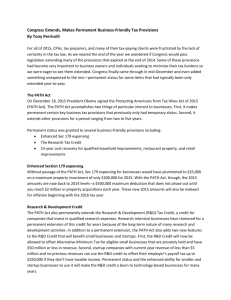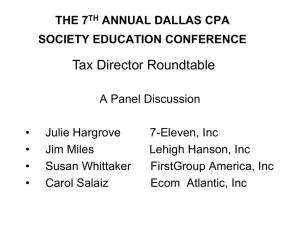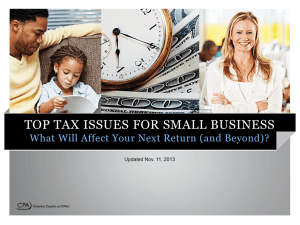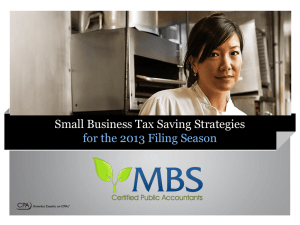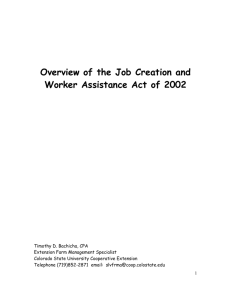File
advertisement
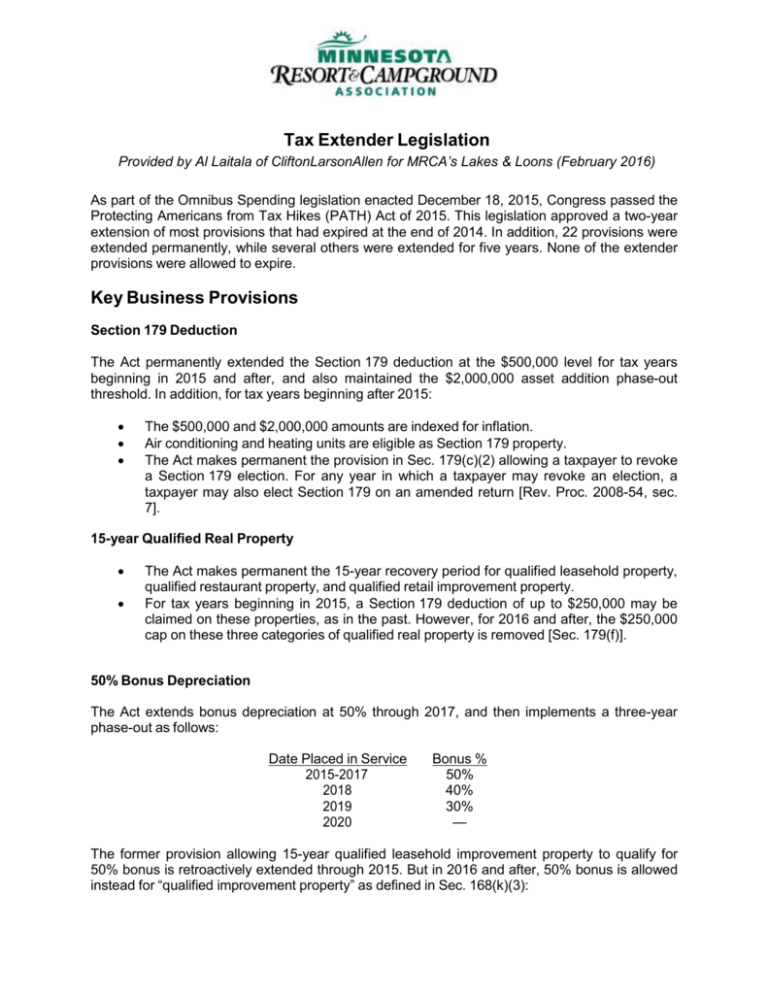
Tax Extender Legislation Provided by Al Laitala of CliftonLarsonAllen for MRCA’s Lakes & Loons (February 2016) As part of the Omnibus Spending legislation enacted December 18, 2015, Congress passed the Protecting Americans from Tax Hikes (PATH) Act of 2015. This legislation approved a two-year extension of most provisions that had expired at the end of 2014. In addition, 22 provisions were extended permanently, while several others were extended for five years. None of the extender provisions were allowed to expire. Key Business Provisions Section 179 Deduction The Act permanently extended the Section 179 deduction at the $500,000 level for tax years beginning in 2015 and after, and also maintained the $2,000,000 asset addition phase-out threshold. In addition, for tax years beginning after 2015: The $500,000 and $2,000,000 amounts are indexed for inflation. Air conditioning and heating units are eligible as Section 179 property. The Act makes permanent the provision in Sec. 179(c)(2) allowing a taxpayer to revoke a Section 179 election. For any year in which a taxpayer may revoke an election, a taxpayer may also elect Section 179 on an amended return [Rev. Proc. 2008-54, sec. 7]. 15-year Qualified Real Property The Act makes permanent the 15-year recovery period for qualified leasehold property, qualified restaurant property, and qualified retail improvement property. For tax years beginning in 2015, a Section 179 deduction of up to $250,000 may be claimed on these properties, as in the past. However, for 2016 and after, the $250,000 cap on these three categories of qualified real property is removed [Sec. 179(f)]. 50% Bonus Depreciation The Act extends bonus depreciation at 50% through 2017, and then implements a three-year phase-out as follows: Date Placed in Service 2015-2017 2018 2019 2020 Bonus % 50% 40% 30% — The former provision allowing 15-year qualified leasehold improvement property to qualify for 50% bonus is retroactively extended through 2015. But in 2016 and after, 50% bonus is allowed instead for “qualified improvement property” as defined in Sec. 168(k)(3): Any improvement to an interior portion of a building which is nonresidential real property The improvement is placed in service after the date the building was first placed in service (but without the former three-year waiting period requirement). The improvement is not attributable to the enlargement of the building, any elevator or escalator, or the internal structural framework of the building. Commentary: For this new improvement definition, there is no longer a requirement that the building be under lease to claim 50% bonus, nor is there a prohibition of a related party lease. Further, the improvements may be either to 15-year qualified real property (i.e., a leasehold improvement, restaurant or retail improvement) or to a 39-year commercial structure, but note that 27.5 year residential property does not qualify. This is the first definition that allows 50% bonus on 39 year property. With respect to bonus depreciation the Act also: Preserves the $8,000 increase in the limitation on the depreciation deduction with respect to passenger vehicles under Sec. 280F. Thus, for vehicles placed in service in 2015, the $3,160 first year limit for cars and the $3,460 limit for trucks and vans are $11,160 and $11,460, respectively, if bonus depreciation applies. When bonus depreciation phases down to 40% and 30% in 2018 and 2019, the $8,000 allowance similarly decreases by 20% each year to $6,400 and $4,800, respectively. Modifies and extends the election of a corporation otherwise eligible for bonus depreciation to claim additional AMT credits in lieu of claiming the bonus depreciation. Extension and Modification of Work Opportunity Tax Credit (WOTC) The WOTC is extended for a five-year period, applying to individuals who begin work for the employer on or before December 31, 2019. A new targeted group of eligible employees is added, effective for individuals who begin work after 2015: Qualified long-term unemployment recipients: – An individual who is in a period of unemployment of not less than 27 consecutive weeks; and – This includes a period in which the individual was receiving unemployment compensation under state or federal law [Sec. 51(d)(15)]. The information from this point on was not included in the Lakes & Loons article due to space limitations. Business Provisions Made Permanent The Act made permanent the following business extender provisions: The five-year built-in gains tax recognition period for C corporations electing S status [Sec. 1374(d)(7)]. The 100% gain exclusion on Section 1202 qualified small business stock held over five years (i.e., stock originally issued to and continually held by the taxpayer as C corporation stock). The rule allowing an S corporation charitable contribution of property to reduce shareholder stock basis by the basis of the contributed property rather than the fair 2 market value charitable deduction [Sec. 1367(a)(2)]. The enhanced above-basis deduction for charitable contributions of food inventory for all taxpayers, with three enhancements for tax years beginning after 2015: – The Act increases the taxable income limit for these donations from 10% to 15%. – For purposes of computing the basis, a taxpayer who does not account for inventory under Sec. 471 or Sec. 263A may treat the basis as being equal to 25% of the fair market value for the “apparently wholesome food” category. – Food which cannot be sold for various reasons (e.g., lack of market, produced for charity) may be valued by reference to the price of similar food items sold by the taxpayer. The employer wage credit for salary continuation payments to employees who are active duty members of the uniformed services is made permanent [Sec. 45P]. However, the credit is made available to employers of any size: – For tax years prior to 2016, an employer qualifies for the credit if employing on average less than 50 employees. – For tax years beginning after 2015, employers of any size may claim the credit. The credit is 20% of the wage continuation payment to a qualified employee, up to $20,000 of wages per employee. Key Individual Provisions The following extenders have been made permanent by the PATH Act: IRA to charity: The exclusion from gross income for otherwise taxable IRA distributions that are directly transferred to charity by the IRA trustee, subject to a $100,000 annual limit and the IRA owner having attained age 70½. Sales tax deduction: The elective ability of an individual to claim state and local sales taxes in lieu of state and local income taxes, using either an IRS table or by accumulating receipts showing sales taxes paid. Teacher supplies: The pre-AGI deduction for up to $250 annually for books, supplies, and other supplemental materials of K-12 teachers and other educators who work at least 900 hours during a school year. However, for tax years beginning after 2015, the $250 amount is indexed for inflation, and professional development expenses are also considered eligible for the deduction. Charitable conservation easements: The enhanced contribution limits for qualified charitable conservation easements are made permanent, allowing individuals to claim these deductions up to the 50%-of-AGI limit with a 15-year carryforward. For qualified farmers and ranchers who place a conservation easement that makes property generally available for agricultural or livestock production, a 100%-of-AGI limit applies to the current and 15-year carryover period. Other permanent provisions: Other extenders made permanent without change include the formula for the refundable portion of the $1,000 child tax credit, the computation of the American Opportunity Tax Credit for higher education costs, the Earned Income Tax Credit (EITC) formula for those with three or more qualifying children and the higher EITC phase-out threshold for joint filers, and the provisions providing parity in the fringe benefit rules for employer-provided transit passes, van pool benefits, and qualified parking. 3 Other Tax Changes in the PATH Act and Omnibus Spending Bill Earlier Form W-2 and 1099-MISC Filing Businesses must file Forms W-2 and Forms 1099-MISC containing nonemployee compensation with the IRS or SSA by January 31, which is the same date they are due to the employee/payee. The later deadlines for paper reporting and electronic filing to the IRS or SSA are no longer available. This change applies to the information statements for the 2016 year, now due January 31, 2017 [Sec. 6071(c)]. Additional Reporting for American Opportunity Tax Credit The legislation requires taxpayers claiming the American Opportunity Tax Credit to disclose the EIN of the educational institution; the institutions are required to report their EIN on Form 1098-T, both effective for tax years beginning after 2015 [Sec. 25(i)(6); Sec. 6050S(b)(2)]. Also, effective in 2016, educational institutions must report only the amounts of tuition and related expenses actually received during the calendar year. In the past, they could report either the amount billed or the amount received [Sec. 6050S(b)(2)(B)(i)]. De minimis expensing safe harbor for taxpayers raised to $2,500 Final tangible property regs permit businesses to elect to expense their outlays for "de minimis" business expenses. This represents an increase from the prior limit of $500. This allows taxpayers to expense purchases of equipment, appliance, etc. that cost $2500 or less each. While the legislation technically take effect in 2016 the IRS has stated that taxpayers will not be challenged if they use the higher amount on 2015 tax returns. Rollover to SIMPLE IRA Previously, a rollover from a qualified plan or traditional IRA to a SIMPLE IRA was not permitted. However, after December 18, 2015, rollovers from employer-sponsored retirement plans and traditional IRAs into a SIMPLE IRA are permitted if the employee has participated in the SIMPLE IRA for a two-year period [Sec, 408(p)(1)B)]. 4
